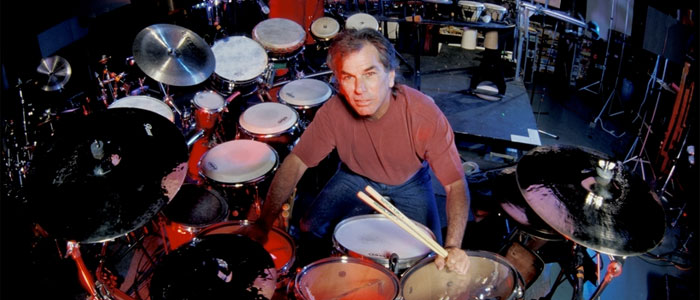Mickey Hart: ‘Grateful Dead’ Drummer Creates Painting Rhythm
Reprinted from Huffington Post
Mickey Hart is legendary in the music world known for his decades as percussionist for the Grateful Dead, as well as being a pivotal innovator. Deadheads and new fans will now have a chance to experience Hart utilizing an entire new art form grown from his love of rhythm. The three time Grammy award winner embarks on premiering his pulsing works as a painter.
Hart is certainly gaining notice now for his works of art that has transcribed his musical genius as a percussionist onto a canvas.
“These visual representations from my sonic driven world are snapshots into the music I am making. The basis of all life is vibratory, from the cosmos to human organism to the rhythms of nature and the music that come from what we make, from what we call culture. These are the worlds of rhythm that envelop us on a daily basis. Understanding these rhythms is essential in our daily lives. These works have been drummed, vibrated into existence. This technique is essential in the creation of my art.”
An Interview with Mickey Hart
Mickey’s amazing journey of over 50 years as a musical legend began when he joined the Grateful Dead in 1967. From his days playing with the “Dead” Hart was always spreading his wings into new endeavors. He not only created his own following as a solo artist, but has continued to work as a music producer, as well as a writer of famed books. Hart has also pursued his lifelong interest in learning about music of different cultures from around the world.
Interviewing the musical genius and budding painter gives new insight into an amazing man.
Carol Ruth Weber: When did you realize your love for music and percussion?
Mickey Hart: My mom and dad were both drummers. I started practicing on my dad’s practice pad and fell in love with the rhythmic sound. I was three or four years old and that was the start. I was a little guy but with a drum in my hand I got to be the big guy and was able to get the dates. Music is a fertility right. The basis of music is to bring people together in life. As a little kid everyone got together and it was fun and the pull was so strong for me. The light went on and I knew that this is what I wanted to do. The light gets brighter and brighter as I play and search. I have learned that the glue about rhythm is what holds the universe together. Vibrations are the essence of life. Everything is moving and if you are rhythmic centric then everything is about a rhythm and being in the groove. Humans are rhythm machines from our neurons firing from our brain. It’s about the human experience – chaos to order and then to chaos and back again to order.
The downbeat began 13.8 billion years ago at the beginning of time and space when the universe exploded. Like Carl Sagan says we are made of star stuff. This didn’t just happen – It’s a rhythm universe. The science of rhythm is where we get the rhythm from. Women were the first drummers back in the Paleolithic time. Rhythm took on a whole other life. Einstein and the cosmic journey is what got us here. When the rhythm is right life is good, when the rhythm stops we die.
CRW: How did you end up getting the gig to play with the iconic Grateful Dead?
MH: Happenstance. The band had just changed their name from the blues band the Warlocks to the Grateful Dead. Bill Kreutzmann was a founding member as drummer and asked me to sit in. With the two drummers the rest was history. Jerry said, “We can take this around the world.” We had that kind of rhythm and fit together.
CRW: It seems that you are an artist that takes joy in growing your art into new forms. Beyond producing and writing your books, how did you morph into your newest identity as a painter?
MH: Working with cosmic rhythms. I became interested in the beginning of the universe and started researching it. Everything has a light and a sound so I wanted to know what the universe sounded like. Ancient philosophers gave musical notation to all of the planets. Pythagoras called it the music of the universe.
I collect source material of sounds from telescopes around the world. The sound decouples from the light because sound cannot travel in space. I turn the light into sound and then compose with that source material which has turned into this new art of painting. I translate the sound back into light to be visual by painting. In the daytime I work with my music and then at night I go into my studio and paint. I paint in layers and layers. After I vibrate it, or drum the work, into existence. Whatever I paint it on I vibrate the visuals into its birth. Each work is a performance of a cosmic event that I am listening to as I paint it. I take rhythmicity and use it as a tool to create my Vibrational Expressionism.
Learning about the universe and how we got here involves learning what it sounds like along with seeing it. I translate the radio waves from the universe into my art in my music and paintings. It is fun and meaningful. The sound of the universe is like a heavenly orchestra. We only see and hear in a small spectrum but now we have scientific instruments that can make sense of it all. I am on the board at the Smithsonian which has a sister connection with NASA allowing me to have a nice relationship with the scientists.
Rhythm plays an essential part in recovery and preventive medicine. When we use rhythm to work with autism they respond to quiet drums and come alive.
CRW: Was traveling always a passion of yours? In 1991 you produced your Grammy Award winning world music album Planet Drum. Who are some of the world renowned percussion masters that you have collaborated with?
MH: It was the first time a percussion orchestra became seen as music. I pulled together amazing percussionists including Zakir Hussain. We all got together and it was history. The Grammy’s created a world music category and we won that. Planet Drum is going to be rereleased on Dec 2 with new tracks – and the dance keeps going! Rhythms of the cosmic and rhythm of humans. Playing drums is healthy.
CRW: Did collecting percussion instruments help give you the drive to conduct research in trying to develop new forms of art?
MH: All that led me to places unknown. Takes you to sacred dimensions which borders on spiritual. Beyond entertainment, it has more meaningful meanings such as prayer. When I dress my instrument I go to church. I want to get the grove and move my mind to other places that are natural. The last thing I think of is playing good. I want to get deeper into myself and understand the world. When the rhythm is right it lasts all night. I’m in the transportation business – moving minds, souls and spirits. It’s about consciousness raising. That’s what the Grateful Dead was built for – as a consciousness razing tool. It was blame free.
CRW: How did you meet Dr. Adam Gazzaley, the leading neuroscientist at UCSF, in order to collaborate with on your thrilling project of ongoing research leading to explore how your own brain cells respond to rhythm. It is awesome how the two of you are exploring ways to identify rhythms that can stimulate different parts of diseased and damaged brain?
MH: I had always been interested in what rhythm does to the brain before, during and after. We started mapping the brain to see what rhythm does to the brain in real time. We wanted to personify the brain waves which is electrical and turn it into sound to play with my own brain wave forms. I map the brain rhythmically. We do science together to see what rhythm does to the brain. My Grandmother had advanced Alzheimer’s and couldn’t speak. I played the drums for her and she spoke my name while I was playing. I realized then that rhythm had medicinal purposes. When your body is in rhythm you are healthy, when the rhythm is broken the body is broken. I testified in front of the senate in 1991 about rhythm and aging.
This is becoming a popular field of investigation since everything goes through the brain. The brain is the master clock. We are researching what rhythms are healthy rhythms in the brain. This is just starting to happen now with the machines we have that can actually read the brain. There are hidden powers in music that bring back memories and brain waves. The music stimulates to wake up the brain.
CRW: Obviously you still have a strong connection with your loving following of deadheads. What is the most fun about touring now with your new band, Dead & Company?
MH: It is a safe place to go that has good vibrations for the band and our constituents. The fun is on the edge playing for others. You feel secure in a group allowing you to go things that you could not do solo. The group is a support group that encourages you to do new things. Everything I am doing now is grown from that encouragement.
In Dead & Company John Mayer adds a lot of life to it. He is young and a great guitar player. He is one of us. Deep Grateful Dead music is a psychic thing. His intuition is great learning the music. He gets down in the trenches playing the music for the right reasons. He took a lot of sacrifice to learn the ins and outs of the music since he was already a star in his own right.
The celebrated drummer’s new artistic journey on his North American Art Tour began in September at the Wentworth Gallery at The Mall at Short Hills in New Jersey as the first stop. This first-to-be-seen collection showcases Hart literally painting a picture of his creative journey combining art, music, and science. Thrilling new and old fans, the artist is making a special appearance on Oct 22 in the unveiling of this creative genius’ fine art.
Hart should certainly be viewed as an innovator and inventor within the art world and beyond. His thirst of weaving his love of life’s rhythms, history and inventiveness into new forms of art and discovery makes the man so much more than a mere drummer in a band. Mickey has set his sights on the future inviting new followers to appreciate unique forms of art as well as his rhythmic exploration to better brain health.
Take Mickey’s lead to follow your own life rhythms and never be afraid to dance!


Comments are closed.